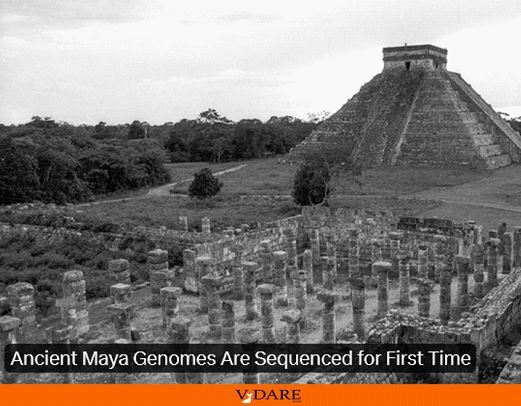


By Steve Sailer
06/13/2024
From The New York Times science section:
Ancient Genomes Reveal Which Children the Maya Selected for Sacrifice
Thousand-year-old DNA from Chichén Itzá offers eye-opening details of the religious rituals of ancient Maya.
By Freda Kreier
Published June 12, 2024In the spring of 1967, workers building a small airport behind Chichén Itzá, the ancient Maya city in Mexico, ran into a problem: Their excavations had uncovered human remains in the pathway of the proposed runway. … Connected to the cistern was a cave containing more than 100 sets of human remains, almost all belonging to children. …
Nearly 60 years later, ancient DNA extracted from 64 of the children is offering new insights into the religious rituals of the ancient Maya and their ties to modern descendants. In a paper published on Wednesday in the journal Nature, an international cohort of researchers revealed that the children — sacrificial victims killed between 500 and 900 A.D. — were all local Maya boys that may have been specifically selected to be killed in sibling pairs.
“These are the first ancient Maya genomes to be published,” said Johannes Krause, an archaeogeneticist at the Max Planck Institute for Evolutionary Anthropology in Leipzig, Germany. …
All 64 of the skulls belonged to boys. “We kept rerunning the tests because we couldn’t believe that all of them were male,” he said. “It was just so amazing.”
… “That obviously flew in the face of the argument that it was mostly young virgin women being thrown into the cenote,” said Jaime Awe, an archaeologist at Northern Arizona University in Flagstaff who was not involved in the study. The obsession with virgins in archaeological circles most likely arose from a combination of colonial ideas and limited data, he said.
Plus heroic fantasies on the part of the male archaeologists: Indiana Jones would have swung in at the last moment and rescued the grateful beautiful virgin being thrown in the cenote.
Now, DNA confirms that the children from the chultún were all male, he said, adding: “We would not have known who they were had the DNA study not been conducted.”
Subsequent genetic testing also showed that many of the boys were related to one another, and among them were two sets of identical twins. Why these boys were chosen for sacrifice is unknown, Dr. Barquera said. But it is possible that siblings, or close relatives, were selected to reflect the trials of the Hero Twins, key figures in Maya cosmology who underwent cycles of sacrifice and rebirth.
Swell. My vague impression is that Mayan religion was less horrible than Aztec religion, but it was still pretty awful
“Rituals from ancient times tend to be particular,” Dr. Awe said. “This study indicates that for some religious ceremonies, it was important that only male children were selected for sacrifice.”
You can see human sacrifice back in the early pages of Greek legend when Agamemnon sacrifices his daughter, Iphigenia, so they can finally head for Troy, and in Genesis when God tells Abraham to sacrifice his son, then says “Just kidding.” The Carthaginians kept it up into high classical times, which gave the Romans a reasonable rationalization for their Punic Wars.
… The team compared the boys’ DNA with that of Maya living in Tixcacaltuyub, a town around an hour’s drive from Chichén Itzá, and found strong genetic continuity between the two groups. As Dr. Barquera expected, the [catastrophic] 1545 [salmonella] pandemic did leave a mark on the Maya, bequeathing Tixcacaltuyub residents with at least one genetic variant associated with salmonella immunity.
Dr. Barquera and a few colleagues traveled to Tixcacaltuyub to share their findings at local schools and with study participants. They also shared previous genetic work conducted by other groups indicating that ancestors of the Maya first moved into the region around 9,000 years ago. Together, the genetic work hints that the peninsula’s large population experienced little migration or genetic exchange since the Maya’s earliest ancestors first moved in.
Yucatan is a peninsula, so, I imagine, it’s more defensible than a place that can be invaded by land from all four directions. It’s mostly a peculiarly featureless terrain: flat, covered with low trees, and with few rivers or lakes, just occasional sinkholes in the limestone. It struck me as looking like a set for some Twilight Zone episode about how an astronaut making the first landing on some other planet comes to notice that his newly discovered planet isn’t a real planet, it’s cheap, unimaginative, repetitious set created by…
DNA provides “clear proof that these people are descendants of the folks that developed one of the world’s most accomplished civilizations,” Dr. Awe said.
Dr. Barquera added that the study participants were thrilled to receive confirmation that they were genetically related to the builders of Chichén Itzá.
“People who live close to these archaeological sites ask, ‘Why do you have so much respect for the people who built these sites, and then treat the Indigenous people who live around them like inferiors?’” he said.
With these DNA results, he added, they can now say: “Look, we’re related to the ones who made these pyramids. So maybe stop being racist toward us.”
Just don’t start sacrificing little boys again.